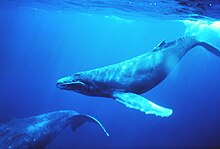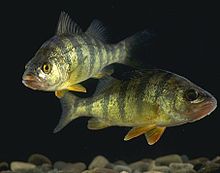User:NatalieRHolmes/Planktivore
| This is the sandbox page where you will draft your initial Wikipedia contribution.
If you're starting a new article, you can develop it here until it's ready to go live. If you're working on improvements to an existing article, copy only one section at a time of the article to this sandbox to work on, and be sure to use an edit summary linking to the article you copied from. Do not copy over the entire article. You can find additional instructions here. Remember to save your work regularly using the "Publish page" button. (It just means 'save'; it will still be in the sandbox.) You can add bold formatting to your additions to differentiate them from existing content. |
Forms of Plankton[edit]
Phytoplankton are usually photosynthetic one-celled organisms. These organisms are usually found near the surface of the water due to their need for light energy for their photosynthetic processes. Phytoplankton provide most of the oxygen that is in the water and provide a large amount of food for other organisms in the water column.[1]
Zooplankton are heterotrophic plankton, which are animals that ingest nutrients rather than producing them via chemical reactions. Zooplankton can provide an important food source for juvenile fish.[2] Some taxa are planktonic for only part of their life cycle. [3]
Forms of Planktivory[edit]
Most fish are planktivores during part or all of their life cycles, especially when they are larvae.[4] There are obligate planktivores, which feed only on plankton, and facultative planktivores, which take plankton when available but eat other types of food as well.[4] The gizzard shad (Dorosoma cepedianum), for example, has a voracious appetite for various forms of plankton across its life cycle. It is an obligate planktivore when it is a juvenile, in part due to its very small mouth size. As it grows it becomes an omnivore, taking phytoplankton, zooplankton, and larger pieces of nutritious detritus. Adult gizzard shad consume large volumes of zooplankton until it becomes scarce, then turn to organic debris for food.[5]
Planktivores obtain food in two ways. Particulate feeders eat planktonic items selectively. Filter feeders process volumes of water and strain food items en masse.[4] "Tow-net" filter feeders swim rapidly with mouths open to filter the water, and pumping filter feeders suck in water via pumping actions. The latter includes stationary animals, such as corals.[4] Another form of filter feeding is a "gulping" behavior, in which the animal takes boluses of water; the alewife (Alosa pseudoharengus) feeds in this manner.[4]
Marine vs. Freshwater Planktivores[edit]
Marine[edit]
Some examples of marine planktivores include: reef manta ray [6], humpback whale[7], right whale, bowhead whale[8] sea salp[9], and coral.[10]

There are also marine invasive species, which are destructive organisms that are non-native and damage the habitat they have invaded.[11] One example of a marine invasive planktivore is the sea walnut.[12]
Planktivores disproportionately contribute to the Indo-Australian Archipelago (IAA) biodiversity hotspot.[13] Within the IAA, planktivorous coral reef fishes are especially concentrated around Indonesia, Papua New Guinea, the Philippines, and the Solomon Islands.[13] Allochthonous particle transportation to coral reefs by ocean currents and tides provides an important food source for planktivorous fish.[13]
Freshwater[edit]
Some examples of freshwater planktivores include: Rainbow smelt, Emerald shiner [14][15], American gizzard shad[16], Alewife[17], Golden shiner[17], Bigmouth buffalo[16], White perch, and Yellow perch.[15]

Some examples of invasive freshwater planktivores include: Bighead carp[17], Spiny water flea[18][14], zebra mussel[19], and Silver carp.[16]
Planktivore Ecology[edit]
Ecological and Biogeochemical Significance[edit]
Plankton species are ecological indicators, meaning their presence gives insight into whether a system is functioning to the benefit of the organisms living within the ecosystem.[15] Since planktivores eat plankton, planktivore presence and their abundance also indicates the health of an ecosystem by implying changes to water quality, water temperature, trophic level interactions, and sources of nutrients flowing to and from a water body.[3] Understanding these changes can aid in assessing the appropriate conservation plans for more than just one species, especially larger, more charismatic species commonly highlighted for fundraising for conservation efforts such as basking sharks, seabirds, and sea turtles.[3]
Effects on water quality[edit]
Seasonal bottom hypoxia is an expanding problem for water quality in marine and freshwater ecosystems.[15] This form of hypoxia is caused by anthropogenic agricultural run-off and run-off from urban areas that result in the addition of chemicals and nutrients into surrounding water systems.[15] Hypoxia affects the pelagic food web by reducing the amount of oxygenated water available for pelagic fishes and invertebrates to breathe.[15] Although pelagic fishes and planktivores are restricted by hypoxic zones, zooplankton species have discovered how to use this to their advantage.[15] Zooplankton species have been observed to seek refuge in hypoxic zones to avoid predation by planktivores that are unable to hunt in low oxygen areas with high temperatures.[15] This causes the predation in layers of lakes, such as the epilimnion, metalimnion, and hypolimnion to be disrupted.[15]
Effects on productivity[edit]
Seasonal upwelling of ocean and freshwaters occurs annually and can cause nutrients to mix around in the water column. This also causes plankton species to mix around instead of primarily existing above the thermocline.[20]
Role in nutrient cycling[edit]

Studies on planktivores and plankton allow humans to better-understand marine management issues surrounding biogeochemical processes, such as ocean acidification.[3] Ocean acidification impacts the ability of some planktviores to form their calcium-based skeletons, such as corals.[21] The increased solubility of calcium carbonate shells and skeletons is due to the addition of carbon dioxide (CO2) which interacts with water (H2O) to make carbonic acid that acidifies the waters. Carbon dioxide bioaccumulates in marine systems and adds to greenhouse gases which promotes climate change. [21]
See Also[edit]
Piscivore - An animal that primarily eats fish meat.
References[edit]
- ^ Peltomaa, Elina T.; Aalto, Sanni L.; Vuorio, Kristiina M.; Taipale, Sami J. (2017). "The Importance of Phytoplankton Biomolecule Availability for Secondary Production". Frontiers in Ecology and Evolution. 5. doi:10.3389/fevo.2017.00128. ISSN 2296-701X. S2CID 32958701.
- ^ Carlson, Douglas M. (June 1978). "The Ecological Role of Zooplankton in a Long Island Salt Marsh". Estuaries. 1 (2): 85–92. doi:10.2307/1351596. JSTOR 1351596. S2CID 84683538.
- ^ a b c d McQuatters-Gollop, Abigail; Johns, David G.; Bresnan, Eileen; Skinner, Jennifer; Rombouts, Isabelle; Stern, Rowena; Aubert, Anaïs; Johansen, Marie; Bedford, Jacob; Knights, Antony (2017-09-XX). "From microscope to management: The critical value of plankton taxonomy to marine policy and biodiversity conservation". Marine Policy. 83: 1–10. doi:10.1016/j.marpol.2017.05.022.
{{cite journal}}: Check date values in:|date=(help) - ^ a b c d e Lazzaro, X. (1987). A review of planktivorous fishes: Their evolution, feeding behaviours, selectivities, and impacts. Hydrobiologia, 146, 97-167.
- ^ Stein, Roy A., et al. (1995). Food-web regulation by a planktivore: exploring the generality of the trophic cascade hypothesis. Canadian Journal of Fisheries and Aquatic Sciences 52(11): 2518-26.
- ^ Axworthy, Jeremy B.; Smith, Joseph M.; Wing, Martina S.; Quinn, Thomas P. (2019-12-XX). "Sex biased individual variation in movement patterns of a highly mobile, near‐shore marine planktivore, the reef manta ray Mobula alfredi". Journal of Fish Biology. 95 (6): 1399–1406. doi:10.1111/jfb.14148. ISSN 0022-1112.
{{cite journal}}: Check date values in:|date=(help) - ^ Wright, Dana L.; Witteveen, Briana; Wynne, Kate; Horstmann-Dehn, Larissa (2016-03-01). "Fine-scale spatial differences in humpback whale diet composition near Kodiak, Alaska". Marine Mammal Science. 32 (3): 1099–1114. doi:10.1111/mms.12311. ISSN 0824-0469.
- ^ Werth, Alexander J; Potvin, Jean; Shadwick, Robert E; Jensen, Megan M; Cade, David E; Goldbogen, Jeremy A (2018-08-28). "Filtration area scaling and evolution in mysticetes: trophic niche partitioning and the curious cases of sei and pygmy right whales". Biological Journal of the Linnean Society. 125 (2): 264–279. doi:10.1093/biolinnean/bly121. ISSN 0024-4066.
- ^ Dobroslavić, T.; Zlatović, A.; Bartulović, V.; Lučić, D.; Glamuzina, B. (2012-09-23). "Diet overlap of juvenile salema (Sarpa salpa), bogue (Boops boops) and common two-banded sea bream (Diplodus vulgaris) in the south-eastern Adriatic". Journal of Applied Ichthyology. 29 (1): 181–185. doi:10.1111/j.1439-0426.2012.02046.x. ISSN 0175-8659.
- ^ Letourneur, Y.; Lison de Loma, T.; Richard, P.; Harmelin-Vivien, M. L.; Cresson, P.; Banaru, D.; Fontaine, M.-F.; Gref, T.; Planes, S. (2013-08-28). "Identifying carbon sources and trophic position of coral reef fishes using diet and stable isotope (δ15N and δ13C) analyses in two contrasted bays in Moorea, French Polynesia". Coral Reefs. 32 (4): 1091–1102. doi:10.1007/s00338-013-1073-6. ISSN 0722-4028.
- ^ body., Marine Debris Program (U.S.), issuing. Invasive species, marine debris as a potential pathway for invasive species. OCLC 1089833509.
{{cite book}}: CS1 maint: multiple names: authors list (link) - ^ Sasson, Daniel A.; Ryan, Joseph F. (2016-03-24). "The sex lives of ctenophores: the influence of light, body size, and self-fertilization on the reproductive output of the sea walnut, Mnemiopsis leidyi". PeerJ. 4: e1846. doi:10.7717/peerj.1846. ISSN 2167-8359. PMC 4811168. PMID 27042395.
{{cite journal}}: CS1 maint: PMC format (link) CS1 maint: unflagged free DOI (link) - ^ a b c Siqueira, Alexandre C.; Morais, Renato A.; Bellwood, David R.; Cowman, Peter F. (2021-03-02). "Planktivores as trophic drivers of global coral reef fish diversity patterns". Proceedings of the National Academy of Sciences. 118 (9): e2019404118. doi:10.1073/pnas.2019404118. ISSN 0027-8424. PMC 7936278. PMID 33593939.
{{cite journal}}: CS1 maint: PMC format (link) - ^ a b Pothoven, Steven A.; Vanderploeg, Henry A.; Höök, Tomas O.; Ludsin, Stuart A. (2012-12-XX). Sprules, Gary (ed.). "Hypoxia modifies planktivore–zooplankton interactions in Lake Erie". Canadian Journal of Fisheries and Aquatic Sciences. 69 (12): 2018–2028. doi:10.1139/cjfas-2012-0144. ISSN 0706-652X.
{{cite journal}}: Check date values in:|date=(help); no-break space character in|first2=at position 6 (help); no-break space character in|first3=at position 6 (help); no-break space character in|first4=at position 7 (help); no-break space character in|first=at position 7 (help) - ^ a b c d e f g h i Stone, Joshua P.; Pangle, Kevin L.; Pothoven, Steven A.; Vanderploeg, Henry A.; Brandt, Stephen B.; Höök, Tomas O.; Johengen, Thomas H.; Ludsin, Stuart A. (2020-07-XX). "Hypoxia's impact on pelagic fish populations in Lake Erie: a tale of two planktivores". Canadian Journal of Fisheries and Aquatic Sciences. 77 (7): 1131–1148. doi:10.1139/cjfas-2019-0265. ISSN 0706-652X.
{{cite journal}}: Check date values in:|date=(help) - ^ a b c Pendleton, Richard M.; Schwinghamer, Christopher; Solomon, Levi E.; Casper, Andrew F. (2017-10-01). "Competition among river planktivores: are native planktivores still fewer and skinnier in response to the Silver Carp invasion?". Environmental Biology of Fishes. 100 (10): 1213–1222. doi:10.1007/s10641-017-0637-7. ISSN 1573-5133.
- ^ a b c Fletcher, Cameron M.; Collins, Scott F.; Nannini, Michael A.; Wahl, David H. (2019). "Competition during early ontogeny: Effects of native and invasive planktivores on the growth, survival, and habitat use of bluegill". Freshwater Biology. 64 (4): 697–707. doi:10.1111/fwb.13255. ISSN 1365-2427.
- ^ Pangle, Kevin L.; Peacor, Scott D. (2009-10-XX). Ramcharan, Charles (ed.). "Light-dependent predation by the invertebrate planktivore Bythotrephes longimanus". Canadian Journal of Fisheries and Aquatic Sciences. 66 (10): 1748–1757. doi:10.1139/F09-133. ISSN 0706-652X.
{{cite journal}}: Check date values in:|date=(help) - ^ Kraemer, Lisa D.; Evans, Douglas; Dillon, Peter J. (2013). "Temporal and spatial variation in Hg accumulation in zebra mussels (Dreissena polymorpha): Possible influences of DOC and diet". Ecotoxicology and Environmental Safety. 91: 71–78. doi:10.1016/j.ecoenv.2013.01.011. ISSN 0147-6513.
- ^ Kerr, Kecia A.; Cornejo, Anabell; Guichard, Frédéric; Crespi Abril, Augusto C.; Collin, Rachel (2015-03-01). "Planktonic predation risk: effects of diel state, season and prey life history stage". Journal of Plankton Research. 37 (2): 452–461. doi:10.1093/plankt/fbv006. ISSN 1464-3774.
- ^ a b Doney, Scott; Balch, William; Fabry, Victoria; Feely, Richard (2009-12-01). "Ocean Acidification: A Critical Emerging Problem for the Ocean Sciences". Oceanography. 22 (4): 16–25. doi:10.5670/oceanog.2009.93. ISSN 1042-8275.
